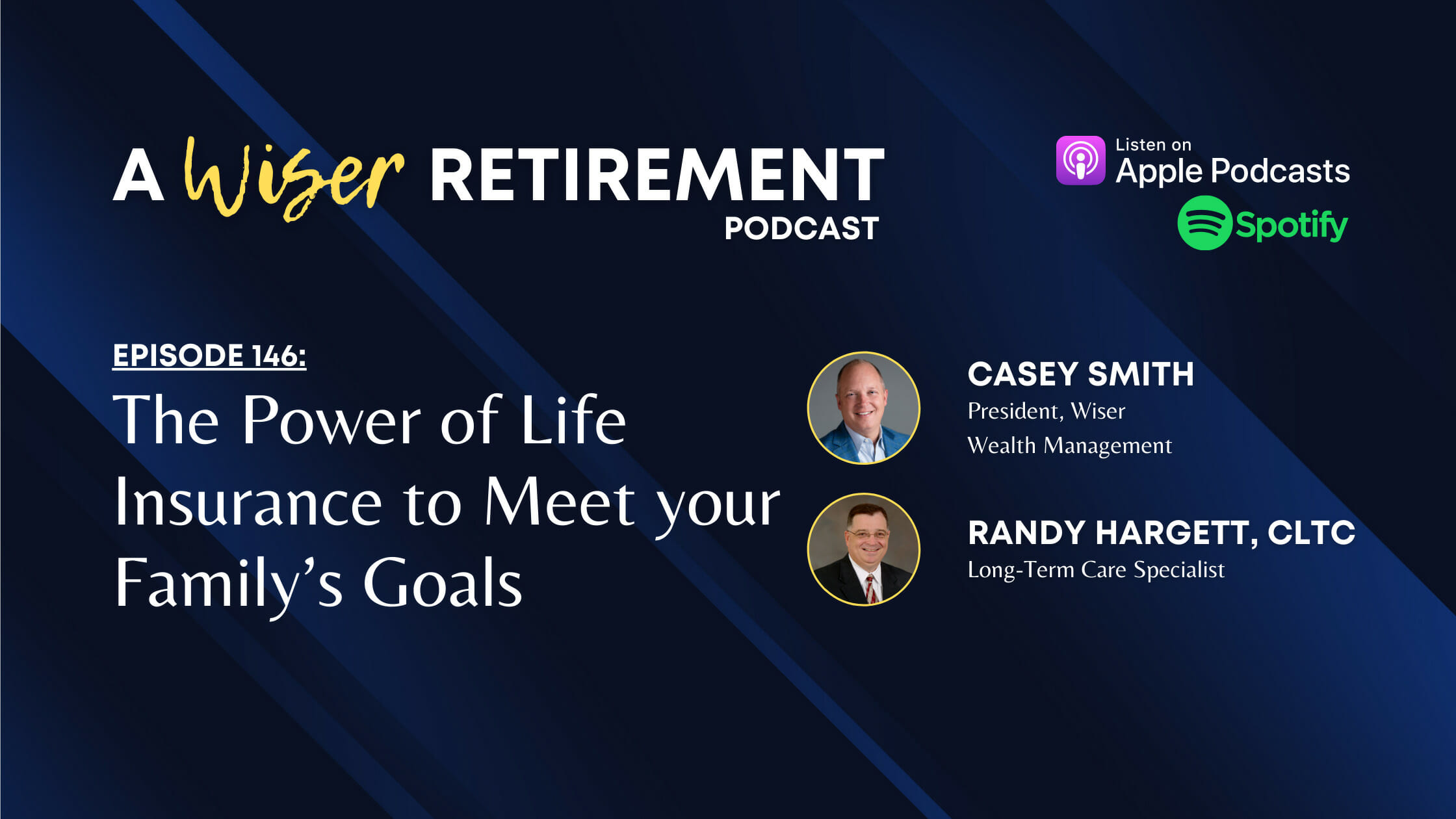
The Power of Life Insurance to Meet your Family’s Goals
On this episode of A Wiser Retirement Podcast, Casey Smith, and Randy Hargett, CLTC, discuss the power of life insurance to meet your family’s goals.
Listen on Apple Podcasts or watch on YouTube:
SUMMARY:
Options for Life Insurance
Being intentional with our finances includes protecting our family through having life insurance. It’s essential to prepare ourselves and the ones we love for the downsides of life as well as the upsides. If you are on a great trajectory, but suddenly pass away, it’s important to make sure that your family will be taken care of.
Life insurance can, in a way, be compared to other insurances that we hold throughout a lifetime. For instance, car insurance or home insurance. Our car insurance changes every time we buy a new car. Our home insurance changes every time we move to a different house. Equally, every time a major life event happens or a life season changes, life insurance changes, too. Consequently, life insurance evolves over time.
2 Types of Life Insurance:
Term Life Insurance
To understand Term life insurance, you can ask the question, what needs to be taken care of if I died today?” So, for example, “If I die now, what are the needs that my family has that would have to be taken care of? Or, that I’d like to be taken care of?” You apply this to different seasons of life, and you can better understand what the needs are and what your life insurance policy should look like.
Permanent Life Insurance
Conversely, the permanent option is better understood by asking the question, “When I die…” There are different reasons why a family would choose permanent life insurance. One example would be, having a special needs child and knowing that the child’s needs go beyond your lifetime.
Long-Term Care Insurance
Additionally, long-term care insurance is under the life insurance umbrella and is regulated like so. For a typical family, you don’t need to purchase a long-term care policy that’s going to cover all of your expenses if you do end up needing long-term care. When it comes to that, it is very likely that you’ll still have other sources of income, like social security and pensions, for example. The recommended approach then is to get a policy that supplements your retirement income, in case you need special care in your old age.
Furthermore, people are starting to purchase long-term care policies earlier in life. 10 years ago, the average age when people bought long-term care policies was 62. Last year, 2022, the average age went down to 53. This is probably a smart decision since the ability to own a long-term care policy is also directly connected to outside factors, for example parents’ medical history.
Download our eBook on “Top Reasons Most Financial Plans Fail“
TIMESTAMPS:
8:45 Options for Life Insurance
10:28 Term Life Insurance
11:27 Permanent Life Insurance
16:28 Long-term Care Insurance
LINKS:
Learn more about Casey Smith, and Missie Beach CFP®, CDFA®
CONNECT:
Twitter, Instagram, Facebook, LinkedIn, and YouTube.
Learn more about A Wiser Retirement podcast and access previous episodes.
Share This Story, Choose Your Platform!
Wiser Wealth Management, Inc (“Wiser Wealth”) is a registered investment adviser with the U.S. Securities and Exchange Commission (SEC). As a registered investment adviser, Wiser Wealth and its employees are subject to various rules, filings, and requirements. You can visit the SEC’s website here to obtain further information on our firm or investment adviser’s registration.
Wiser Wealth’s website provides general information regarding our business along with access to additional investment related information, various financial calculators, and external / third party links. Material presented on this website is believed to be from reliable sources and is meant for informational purposes only. Wiser Wealth does not endorse or accept responsibility for the content of any third-party website and is not affiliated with any third-party website or social media page. Wiser Wealth does not expressly or implicitly adopt or endorse any of the expressions, opinions or content posted by third party websites or on social media pages. While Wiser Wealth uses reasonable efforts to obtain information from sources it believes to be reliable, we make no representation that the information or opinions contained in our publications are accurate, reliable, or complete.
To the extent that you utilize any financial calculators or links in our website, you acknowledge and understand that the information provided to you should not be construed as personal investment advice from Wiser Wealth or any of its investment professionals. Advice provided by Wiser Wealth is given only within the context of our contractual agreement with the client. Wiser Wealth does not offer legal, accounting or tax advice. Consult your own attorney, accountant, and other professionals for these services.





